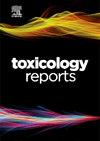Valproic acid intoxication – The importance of toxicological analysis and correct management: A case report
Q1 Environmental Science
引用次数: 0
Abstract
Introduction
Valproic acid (VPA) is an anticonvulsant widely used in treating epilepsy which can occur cases of poisoning in overdose situations.
Case description
A 15-year-old girl purposely ingested about 100 drug tablets according to family members. Gastric lavage with activated charcoal was performed at home using a nasogastric tube and patient just was taken to the hospital around 10 h after drug ingestion, arriving in shock state. All laboratorial parameters were altered together a suspect of aspiration pneumonia with the presence of gross perihilar infiltrated in the right lung. Immunoassay screening test did not detect any substance; LC-UV detected quetiapine (> 150 ng/mL) while GC-MS determined 977.96 µg/mL of valproic acid in the patient’s plasma, confirming valproic acid intoxication. Appropriate life support was performed in the patient during hospitalization; however, she died two days later, reaching her suicide.
Conclusions
Prognosis could be favorable if the patient was taken immediately to hospital emergency, considering the complexity of managing poisoning. Patient´s anamnesis must be carefully analyzed by the healthcare professional to avoid false conclusions and toxicological analysis is extremely important to clarify suspected poisoning.
丙戊酸中毒-毒理学分析和正确处理的重要性:1例报告。
简介:丙戊酸(VPA)是一种广泛用于治疗癫痫的抗惊厥药,在过量情况下可发生中毒。病例描述:一名15岁的女孩,据其家人说,故意服用了约100片药物。在家中使用鼻胃管进行活性炭洗胃,患者在服药后10 h左右才被送往医院,到达休克状态。所有的实验室参数都改变了,同时怀疑吸入性肺炎,右肺门周围有明显浸润。免疫分析筛选试验未检出任何物质;LC-UV检出喹硫平(> 150 ng/mL), GC-MS检出丙戊酸977.96 µg/mL,确认丙戊酸中毒。在住院期间给予患者适当的生命支持;然而,两天后她去世了,达到了自杀的目的。结论:考虑到中毒处理的复杂性,如果患者立即送往医院急救,预后可能较好。医疗专业人员必须仔细分析患者的记忆,以避免错误的结论,毒理学分析对澄清疑似中毒非常重要。
本文章由计算机程序翻译,如有差异,请以英文原文为准。
求助全文
约1分钟内获得全文
求助全文
来源期刊

Toxicology Reports
Environmental Science-Health, Toxicology and Mutagenesis
CiteScore
7.60
自引率
0.00%
发文量
228
审稿时长
11 weeks
 求助内容:
求助内容: 应助结果提醒方式:
应助结果提醒方式:


